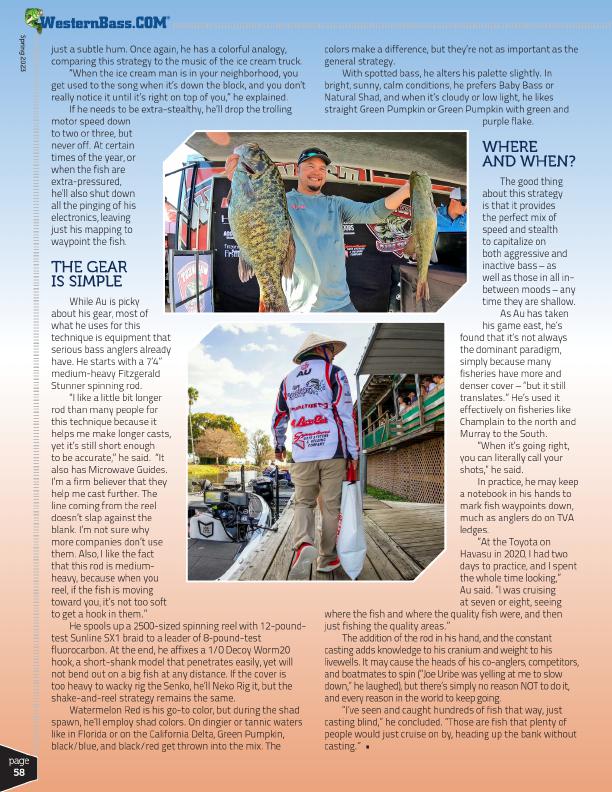
®
Spring 2023
page 58
just a subtle hum. Once again, he has a colorful analogy, comparing this strategy to the music of the ice cream truck.
“When the ice cream man is in your neighborhood, you get used to the song when it’s down the block, and you don’t really notice it until it’s right on top of you,” he explained.
If he needs to be extra-stealthy, he’ll drop the trolling motor speed down to two or three, but never off. At certain times of the year, or when the fish are extra-pressured, he’ll also shut down all the pinging of his electronics, leaving just his mapping to waypoint the fish.
THE GEAR IS SIMPLE
While Au is picky about his gear, most of what he uses for this technique is equipment that serious bass anglers already have. He starts with a 7’4” medium-heavy Fitzgerald Stunner spinning rod.
“I like a little bit longer rod than many people for this technique because it helps me make longer casts, yet it’s still short enough to be accurate,” he said. “It also has Microwave Guides. I’m a firm believer that they help me cast further. The line coming from the reel doesn’t slap against the blank. I’m not sure why more companies don’t use them. Also, I like the fact that this rod is medium- heavy, because when you reel, if the fish is moving toward you, it’s not too soft to get a hook in them.”
He spools up a 2500-sized spinning reel with 12-pound- test Sunline SX1 braid to a leader of 8-pound-test fluorocarbon. At the end, he affixes a 1/0 Decoy Worm20 hook, a short-shank model that penetrates easily, yet will not bend out on a big fish at any distance. If the cover is too heavy to wacky rig the Senko, he’ll Neko Rig it, but the shake-and-reel strategy remains the same.
Watermelon Red is his go-to color, but during the shad spawn, he’ll employ shad colors. On dingier or tannic waters like in Florida or on the California Delta, Green Pumpkin, black/blue, and black/red get thrown into the mix. The
colors make a difference, but they’re not as important as the general strategy.
With spotted bass, he alters his palette slightly. In bright, sunny, calm conditions, he prefers Baby Bass or Natural Shad, and when it’s cloudy or low light, he likes straight Green Pumpkin or Green Pumpkin with green and
purple flake.
WHERE AND WHEN?
The good thing
about this strategy
is that it provides
the perfect mix of
speed and stealth
to capitalize on
both aggressive and
inactive bass – as
well as those in all in-
between moods – any
time they are shallow.
As Au has taken
his game east, he’s
found that it’s not always
the dominant paradigm,
simply because many
fisheries have more and
denser cover – “but it still
translates.” He’s used it
effectively on fisheries like
Champlain to the north and
Murray to the South.
“When it’s going right,
you can literally call your
shots,” he said.
In practice, he may keep
a notebook in his hands to
mark fish waypoints down,
much as anglers do on TVA
ledges.
“At the Toyota on
Havasu in 2020, I had two
days to practice, and I spent
the whole time looking,”
Au said. “I was cruising
at seven or eight, seeing where the fish and where the quality fish were, and then just fishing the quality areas.”
The addition of the rod in his hand, and the constant casting adds knowledge to his cranium and weight to his livewells. It may cause the heads of his co-anglers, competitors, and boatmates to spin (“Joe Uribe was yelling at me to slow down,” he laughed), but there’s simply no reason NOT to do it, and every reason in the world to keep going.
“I’ve seen and caught hundreds of fish that way, just casting blind,” he concluded. “Those are fish that plenty of people would just cruise on by, heading up the bank without casting.” •